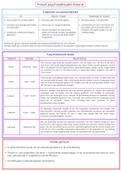Summary
Summary GDL Equity & Trusts Exam Revision Notes
- Module
- Land Law
- Institution
- City University (City)
GDL Equity and Trusts Exam Revision Notes Comprehensive easy to follow revision notes that summarise the essential cases, legislation and persuasive authorities for each topic. Topics covered: The Three Certainties, The Beneficiary Principle (Purpose Trust) , Charitable Trusts, Secret Trusts, Cons...
[Show more]












